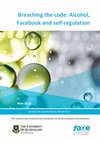Papers by Michelle Shaul
Long-lasting effects of very preterm birth on brain structure in adulthood: A systematic review and meta-analysis
Neuroscience & Biobehavioral Reviews
Recognise responsible and excessive consumption is not just about what brands say, but about th... more Recognise responsible and excessive consumption is not just about what brands say, but about the consumer contributions brands routinely invite. Consider what aspects of people's identities and lives it is appropriate for alcohol brands to engage with. Specify sponsorships, activations and real-world promotions as intrinsic to the production of brands.
Prevention Research, Jul 1, 2013

Mobile Media and Communication, 2015
Brands are a critical part of the ongoing experimentation that underpins the development of mobil... more Brands are a critical part of the ongoing experimentation that underpins the development of mobile social media platforms like Instagram. Instagram had no dedicated advertising or analytics tools until 2014 so, in the absence of such devices, brands have developed uses of the platform that engage with the productive ability of cultural intermediaries and consumers to create and circulate images of their bodies, everyday lives and cultural practices. This article examines the Instagram activities of the global vodka brand Smirnoff and the fashion retailer General Pants. Each brand engages with cultural intermediaries and builds themed activations at cultural events to orchestrate the production of images. Following Wissinger’s (2007a) study of fashion models, we conceptualize Instagram as an image machine that captures and calibrates attention. Instagram expands the terrain upon which brands operate by dispersing the work of creating and engaging with images into consumers’ everyday lives. The efforts made by brands to experiment with mobile media demonstrate the need to critically examine how participatory, discursive and algorithmic modes of control are interrelated.
Reports and policy by Michelle Shaul

This report builds on our study of the activity of the top twenty alcohol brands on Facebook in A... more This report builds on our study of the activity of the top twenty alcohol brands on Facebook in Australia during 2012 (Carah 2014) and a complaint made to the Advertising Standards Board (ASB) and Alcohol Beverages Advertising Code (ABAC) Complaints Panel regarding the pages of Victoria Bitter (VB) and Smirnoff in 2012 (Brodmerkel and Carah 2013).
In a 2012 submission we asked the ASB and ABAC to consider whether content posted on the Facebook pages of VB and Smirnoff breached standards in the code relating to excessive consumption, depiction of people under 25, offensive content, and the suggestion that alcohol improved mood and social success.
In a landmark decision, the ASB and ABAC both upheld the complaint, ruling for the first time that their alcohol advertising codes should apply to a brand’s Facebook page and that advertisers were directly responsible for the content that users generated on that platform, including comments made on a Facebook post.
Furthermore, the ASB and ABAC determined that user-generated content needed to be evaluated in the context in which it appears, taking account of how brands stimulate particular conversations.
This report examines content posted by alcohol brands to Facebook during 2012 following the determination of the ASB and ABAC (see Carah 2014) in order to assess compliance. The report poses three key research questions:
Are the breaches of the code seen in the 2012 ruling against VB and Smirnoff more widely evident on the Australian Facebook pages of alcohol brands?
Are alcohol brands complying with their own self-regulatory codes in light of the decisions by the ASB and ABAC in 2012?
And are the current regulatory codes appropriate for regulating alcohol brand activity on Facebook?
Uploads
Papers by Michelle Shaul
Reports and policy by Michelle Shaul
In a 2012 submission we asked the ASB and ABAC to consider whether content posted on the Facebook pages of VB and Smirnoff breached standards in the code relating to excessive consumption, depiction of people under 25, offensive content, and the suggestion that alcohol improved mood and social success.
In a landmark decision, the ASB and ABAC both upheld the complaint, ruling for the first time that their alcohol advertising codes should apply to a brand’s Facebook page and that advertisers were directly responsible for the content that users generated on that platform, including comments made on a Facebook post.
Furthermore, the ASB and ABAC determined that user-generated content needed to be evaluated in the context in which it appears, taking account of how brands stimulate particular conversations.
This report examines content posted by alcohol brands to Facebook during 2012 following the determination of the ASB and ABAC (see Carah 2014) in order to assess compliance. The report poses three key research questions:
Are the breaches of the code seen in the 2012 ruling against VB and Smirnoff more widely evident on the Australian Facebook pages of alcohol brands?
Are alcohol brands complying with their own self-regulatory codes in light of the decisions by the ASB and ABAC in 2012?
And are the current regulatory codes appropriate for regulating alcohol brand activity on Facebook?